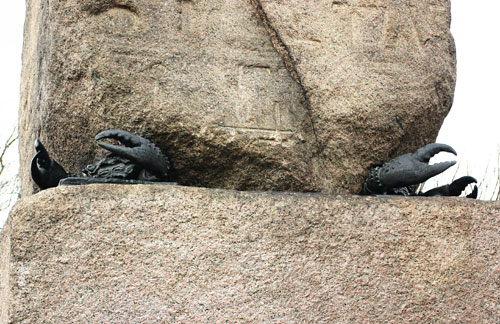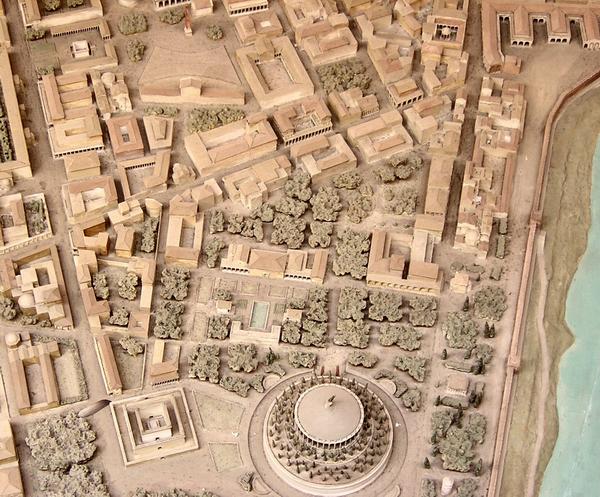April 30th, 2007

The obelisk-gnomon of the Augustus sundial in Rome (April 11 post here) has a lot of company–while unusual to use one as a sundial, Rome is a thicket of relocated obelisks. New York also has one: Cleopatra’s Needle in Central Park. Damaged at the base in the extensive and labor intensive move early on in its history, Cleopatra’s Needle is stabilized by giant bronze crabs, which were associated with the worship of Apollo and the sun (and thus the divinity of the Pharohs) and so were accepted by the Egyptians as an appropriate patch job.
April 11th, 2007

Many large tall pointy shapes have been used as shadow-casters for sundials throughout history. Here’s an excerpt from Sundials: History, Art, People, Science, by Mark Lennox-Boyd, about one such in Rome:
This was the obelisk of Psammetichus II, the first of the many Egyptian obelisks to be removed to Rome. Augustus took it as war booty after the defeat of Cleopatra and her lover Mark Anthony at Actium in 31 BC and had it made into the gnomon of his sundial. On the base is a Latin inscription, which translated reads in part: ‘Emperor Augustus, son of divine Caesar, dedicated the obelisk to the sun when Egypt had been brought under the sway of the Roman people.’ It was a considerable achievement to get the massive stone back to Rome intact and Augustus had the ship that carried it laid up in the harbour near Rome as a tourist attraction. It came from Heliopolis, City of the Sun, in Egypt. The Emperor associated himself with the sun, and the obelisk was a visual symbol erected to demonstrate his power.
In 1748 it was excavated and re-erected with difficulty, for it had been greatly damaged by fire, possibly when Rome was sacked in 1084. The obelisk stands today in the Piazza del Parlamento in front of the Italian Parliament building less than 55 yards from its original location, and from its tip it still tells the time of noon against a modern bronze line set into the pavement.
Augustus was born on the date of the autumn equinox. The straight line marking the equinox points eastwards precisely to teh Ara Pacis – The Altar of Peace. This contemporaneous monument had been constructed to symbolize his achievements and the new era of peace occasioned by his immensely successful reign, during which he had extended the frontiers of the empire and brought stability and prosperity to the people who were profoundly unsettled after the assassination of Julius Caesar. It is claimed the obelisk is also orientated to symbolize the completion of his life. The northern edge points a little to the west and directly towards the gigantic Mausoleum of Augustus.
This great astronomical instrument, one of the most remarkable monuments of imperial Rome, symbolizes the defeat of Egypt, the achievements and the power, the birth and death of the greatest of Roman emperors and the peace and prosperity he inaugurated.
The illustration (below) shows the plan of the dial according to Dr Buchner’s hypothesis. Readings were taken from the tip of the obelisk. The straight lines show unequal hours; the central horizontal one is the line followed by the tip of the days of the equinox. The curves show the position followed by the tip at different dates, dignified by the signs of the zodiac, the lowest curve being for the summer solstice when the sun is at its highest.

Below–a model of ancient Rome (from a site with more info), with the Augustus sundial obelisk at the upper left and his mausoleum in the lower right (large, round).



